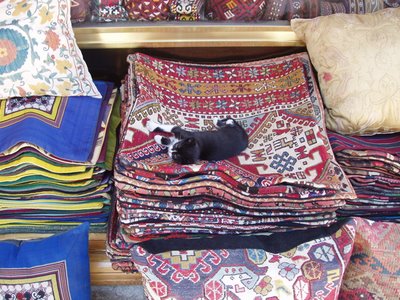Thursday, June 29, 2006
Travel Literature, More Broadly
Tuesday, June 27, 2006
Travel Book List
Here is an interesting list of travel books, in blog format, with lots of comments suggesting still more travel books. I've read very few of them, but I think I'll try to read more:
World Hum's Top 30 Travel Books
Sunday, June 25, 2006
Indiana
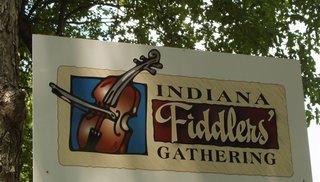
We parked the car on the street in Battleground, and walked a block to the Tippecanoe Battlefield Memorial for the Saturday afternoon concert. Fiddlers and other musicians and fans were camping in tents all around the concert area. The Gathering started with a concert Friday night, and continued all weekend with a variety of activities and concerts. Fiddlers fiddled all around the tents and parked cars, so music was everywhere.
Elaine and Larry had us bring folding chairs so that we would be comfortable during the music as well as during long pauses between sets. People were very informal, walking around, buying food, talking and rearranging chairs all during the concert.

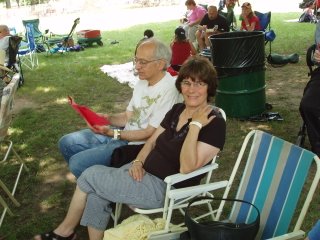
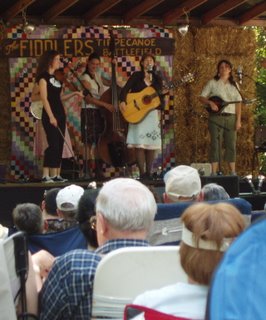
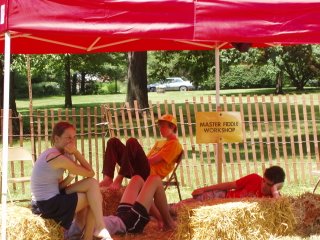

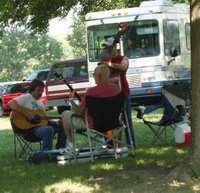
Battleground, Indiana, now the site of the annual Fiddlers' Gathering, in 1811 was the site of the Battle of Tippecanoe. General William Henry Harrison (much later to be president) with around 900 men, defeated around 900 Indians, led by "The Prophet."
The memorial with its statue of General Harrison:

Friday, June 23, 2006
"Syriana"
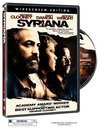
"Syriana" exceeds the requirements that films allow one to travel. It jumps around: Beruit, unnamed Arabian oil fields, Washington D.C. and nearby points on the CIA map, Texas, Geneva, the Spanish riviera, more Middle East, maybe more far east. I guess this is a post-modern movie. I think I like things a little more linear, including more car chases and not quite so many plotlines.
We are trying to catch up with Netflix: over 50 movies in the queue!
Back to Turkey
Here are a few more photos from the trip. First, a very massive head, lying on its side because it was re-used as support for an underground cistern. Roman water systems remain stunning evidence of their great technology. Aqueducts and several cisterns from the Byzantine era are among the most dramatic early monuments of Istanbul (though of course Santa Sophia is the greatest).

Colorful markets, with their small specialized shops or stalls, are irresistible to a photographer. In one area, we drove past blocks and blocks of second-floor display windows with gowns and formal men's attire. Elsewhere, special markets or street stalls sell pots and pans, electrical equipment, clothing, and so on. Within the Grand Bazaar, there are areas mainly dedicated to leather goods, textiles, gold/jewelry, and cafes. Outside the Grand Bazaar is a used book area. The Spice Bazaar offers primarily spices, dried fruits, and other condiments, though I bought a great pair of sunglasses there. Food markets or market streets are convenient to most residential areas: remember, the population of Istanbul is 12 million or more, so they need a lot of shopping space.
We took these photos at the Spice Bazaar and the marketing area of Kadikoy on the Asian side of the Bosphorous. Our friends explained that porters with baskets on their backs hire themselves out to housewives who need their help to carry home their purchases:


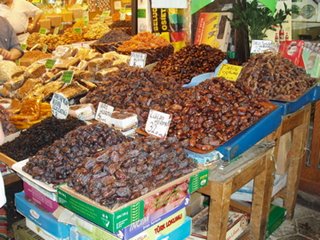



Colorful markets, with their small specialized shops or stalls, are irresistible to a photographer. In one area, we drove past blocks and blocks of second-floor display windows with gowns and formal men's attire. Elsewhere, special markets or street stalls sell pots and pans, electrical equipment, clothing, and so on. Within the Grand Bazaar, there are areas mainly dedicated to leather goods, textiles, gold/jewelry, and cafes. Outside the Grand Bazaar is a used book area. The Spice Bazaar offers primarily spices, dried fruits, and other condiments, though I bought a great pair of sunglasses there. Food markets or market streets are convenient to most residential areas: remember, the population of Istanbul is 12 million or more, so they need a lot of shopping space.
We took these photos at the Spice Bazaar and the marketing area of Kadikoy on the Asian side of the Bosphorous. Our friends explained that porters with baskets on their backs hire themselves out to housewives who need their help to carry home their purchases:





Sunday, June 18, 2006
"The Syrian Bride"
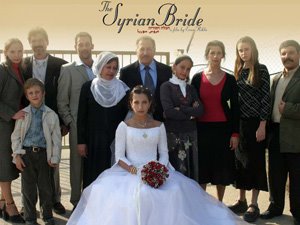
On our visit to Mrar, the Druze village, we met Adnan Tarabshi, an actor in the film The Syrian Bride (2004). When he's not acting in films, he is leading the community center of Mrar. We were most anxious to see the film: fortunately, the DVD came out the day we returned, and we ordered it from Netflix. It's wonderful. The picture shows the bride with her family. Her sister's husband, played by Tarabshi, is on the far right.
The film portrays these two sisters and their complex family. Location is a Golan Druze village, formerly Syrian territory, now under control of Israel. The situation in this village is completely different from the situation of the village that we visited. The Golan Druze consider themselves to be Syrian, as the film depicts. The Israeli Druze in Mrar and many other villages near Haifa are completely loyal to Israel, including service in the Israeli military.
The major action in the film occurs in a military zone on the border between Israel and Syria, as the bride tries to cross the border -- irrevocably -- to marry a Syrian film star. Her prospective husband and his family stand on the far side of many gates and fences as she waits for approval for her paperwork. The film is full of political irony and emotional interchanges among family members, village elders, police, marching demonstrators, officious border guards, a woman UN representative who had had a relationship with the bride's brother, and so on. As the film comes to an end, the frightened bride waits and waits in the sun behind the last fence, dressed in a long white wedding dress:

We really enjoyed the film, and were happy that we had met one of the excellent actors.
Thursday, June 15, 2006
Memories of Turkey
Santa Sophia connects modern Turkey to ancient Byzantium, once the capital of the Eastern Roman Empire. Santa Sophia's builders worked at the start of this little-remembered era. Santa Sophia, church and architectural masterpiece, was at the city's heart for over a millenium of Byzantine history.
The Ottoman era started with a massive effort to add mosques of similar grandeur. Sultans hoped that the new buildings would compete with Santa Sophia's domininance of the skyline. But it dominates still. My first reading project now that I'm back is to learn more about the Byzantine era.
Here are two photos that we took: Santa Sophia in 2006.
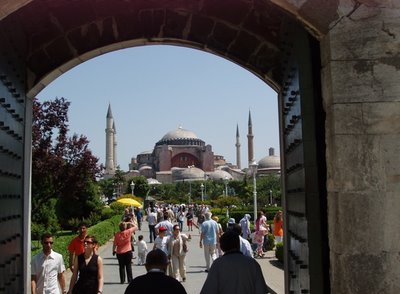
SANTA SOPHIA FROM THE BLUE MOSQUE
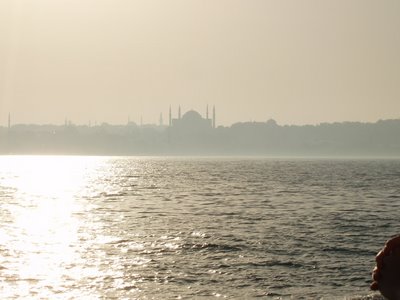
SANTA SOPHIA FROM A FERRY BOAT, LATE AFTERNOON
The Ottoman era started with a massive effort to add mosques of similar grandeur. Sultans hoped that the new buildings would compete with Santa Sophia's domininance of the skyline. But it dominates still. My first reading project now that I'm back is to learn more about the Byzantine era.
Here are two photos that we took: Santa Sophia in 2006.

SANTA SOPHIA FROM THE BLUE MOSQUE

SANTA SOPHIA FROM A FERRY BOAT, LATE AFTERNOON
Monday, June 12, 2006
My List of Travel Books
Great Cities
 | This list includes: • Budapest 1900: A Historical Portrait of a City and Its Culture by John Lukacs • Salonica, City of Ghosts : Christians, Muslims and Jews, 1430-1950 by Mark Mazower • Istanbul : Memories and the City by Orhan Pamuk See entire list |
Thursday, June 08, 2006
You're never there till you're there...
... that's always been our motto for air travel, and this time, we finally landed in Detroit airport 12 hours later than scheduled. Details are completely uninteresting, including the fleabag hotel in downtown Newark "courtesy" of Continental.
I will select a few more photos to reflect various themes from Istanbul and Israel that I didn't cover in previous posts. Then the "maetravels" definition will either change, or I'll put the blog on hold until some as-yet unplanned trip.
I will select a few more photos to reflect various themes from Istanbul and Israel that I didn't cover in previous posts. Then the "maetravels" definition will either change, or I'll put the blog on hold until some as-yet unplanned trip.
Tuesday, June 06, 2006
Goodbye Hello Goodbye
If the flight from Istanbul to Tel Aviv had been more than an hour and a half, we would be a couple of basket cases. Around 40 women who had just gone on a tour to Cappadocia by jeep were seated all around us. Throughout the flight, they were shouting at each other at the tops of their voices, taking flash pictures, clapping, singing, and making other rowdy noises. It was grating. But our motto on such flights is: if we don't want to hear people shouting in Hebrew, why are we going to Israel? Where everyone shouts.
Luckily the flight landed early, the bag (which El Al wouldn't accept as carryon) came down the chute quickly, a taxi was available to take us to Janet's house in Kiriyat Ono immediately, we were able to direct the taxi driver (he applauded when we said we were here) -- and we hope all goes as well tomorrow as we fly to New York and on to DTW.
Adventures of the day -- after breakfast at the nearby mall with Janet and Abigail -- a visit to Janet's favorite wine store, which we have been talking about since we got here. We enjoyed looking at the big selection of Israeli boutique wines and worldwide imports, and tasted a bit of Aussie red. Unfortunately we are daunted at the sight of our pile of luggage, and can only regret that we didn't manage to buy some bottles to drink while we were here last month. The rise of Israeli wine and Israeli taste for a variety of wines is another of the changes that we can see over the 8 year gap between our trips.
Next year in Jerusalem! And Kiriyat Ono.
Luckily the flight landed early, the bag (which El Al wouldn't accept as carryon) came down the chute quickly, a taxi was available to take us to Janet's house in Kiriyat Ono immediately, we were able to direct the taxi driver (he applauded when we said we were here) -- and we hope all goes as well tomorrow as we fly to New York and on to DTW.
Adventures of the day -- after breakfast at the nearby mall with Janet and Abigail -- a visit to Janet's favorite wine store, which we have been talking about since we got here. We enjoyed looking at the big selection of Israeli boutique wines and worldwide imports, and tasted a bit of Aussie red. Unfortunately we are daunted at the sight of our pile of luggage, and can only regret that we didn't manage to buy some bottles to drink while we were here last month. The rise of Israeli wine and Israeli taste for a variety of wines is another of the changes that we can see over the 8 year gap between our trips.
Next year in Jerusalem! And Kiriyat Ono.
Monday, June 05, 2006
Grand Bazaar Finale
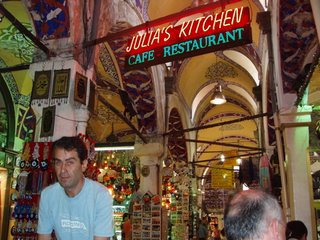

Our last morning in Istanbul was time for the Grand Bazaar. We didn't know what we were going to buy, but our goals evolved, and we enjoyed the vastness of it all, the painted archways, narrow streets, and constant invitations to look at rugs, scarves, jewelry, tiles, purses, shoes, leather jackets, trinkets, inlaid boxes, more rugs, and so on. We had lunch at a place called "Julia's Kitchen."
Sunday, June 04, 2006
All right, we did buy a rug...
The Chora Church, Istanbul
Mosaics and frescos in the Chora Church date from the beginning of the 14th century. They are breathtaking. Despite centuries of neglect and intentional defacing (that means cutting off the faces if your religion says no images) -- the artworks have survived. The fresco below shows Jesus pulling Adam and Eve out of their graves.

Here is the Byzantine city wall near the church. For its first 80 years, many centuries ago, the church was outside the wall, but this wall -- from the Golden Horn to the Sea of Marmara -- soon enclosed a greater Constantinople:


Here is the Byzantine city wall near the church. For its first 80 years, many centuries ago, the church was outside the wall, but this wall -- from the Golden Horn to the Sea of Marmara -- soon enclosed a greater Constantinople:

Photos of the Great Island
A romantic view as we walked down from the Greek monastery at the top of the hill. It inspired a conversation about orientalism, the love of travel to exotic oriental destinations -- but with a condescending view of the inhabitants. Our host has read a great deal about it and he doesn't like it!
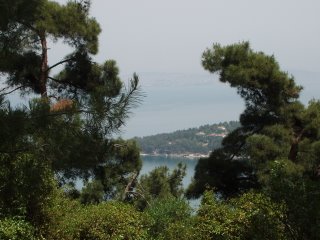
Everything here goes by horse cart:


Everything here goes by horse cart:

Police Escort
Our destination today: the ferry last stop, called "Great Island": Buyukada, and its Greek monastary and little church of St. George, who does appear in a number of icons with his sword and writhing dragon. At the mountain top along with the church is a restaurant with delicious salads and grilled meats. The problem: at the end of a slow horse carriage ride in this car-free island, it's a long hot walk up a cobblestone road.
Though it winds through glorious pine woods with frequent framed vistas of nearby islands in the mist, it's a very hard walk. Our host's solution -- he had called the local police chief and requested for his important American visitor a ride in the police van! We much enjoyed the walk back down, and the slow carriage ride into the village, where horse carts carry people, groceries, construction equipment, and everything else.
To start the day, accompanied by our host and his family, we had walked around our host's childhood neighborhood on the Asian side, called Kadikoy. From the boat stop (Iskele) our ferryboat went in the opposite direction from that of the previous day, this time toward the islands in the Sea of Marmara.
Though it winds through glorious pine woods with frequent framed vistas of nearby islands in the mist, it's a very hard walk. Our host's solution -- he had called the local police chief and requested for his important American visitor a ride in the police van! We much enjoyed the walk back down, and the slow carriage ride into the village, where horse carts carry people, groceries, construction equipment, and everything else.
To start the day, accompanied by our host and his family, we had walked around our host's childhood neighborhood on the Asian side, called Kadikoy. From the boat stop (Iskele) our ferryboat went in the opposite direction from that of the previous day, this time toward the islands in the Sea of Marmara.
Friday, June 02, 2006
Istanbul

View of the Bosphorous from our hotel balcony.

Mihrimah's Mosque, designed by Sinan: we were unable to enter this mosque because it was damaged by the most recent earthquake, but walked around. Nearby are the old Byzantine walls. The gate in the wall across the street from the mosque is the location where Mehmet and his troops first breached the wall in the final defeat of Byzantine Constantinople.

Rustam Pasha mosque: also by Sinan. Mihrimah was Suliman's daughter. Rustam Pasha was her husband. Suliman had Sinan design and build these mosques to honor them.
Istanbul is wired too
Our hotel here turns out to have free wireless in the room. Our room also has a balcony with a view looking across the Bosphorous and the mountains on the other side, which is Asia. Here we are in Europe.
After two days of touring, we are exhausted. Len's colleague here has a standard tour that he has given to many colleagues. So far we have seen around 7 mosques including ex-mosque Santa Sophia. This morning we saw my favorite, Rustam Pasha, which has red-white-turquoise-and blue tiles on every wall. Each panel has a unique design for its tiles, with a range of patterns and varying degrees of tiny intricacy. Ceilings are either coffered wood or plaster decorated with rather simple stencilled designs (I guess they are stencilled, maybe just painted). The ensemble is breathtaking. Although the architect Sinan designed several much larger mosques that we have seen, this one is very special.
This afternoon we had a long ride on a passenger ferry up the Bosphorous -- we saw dolphins jumping in the water, boys swimming in ugly green algae-covered places, fishermen off the dock pulling in a net full of sardines (wanted) and jellyfish (thrown back in), the two huge bridges that link Europe with Asia, and vast numbers of mostly beautiful buildings. The ferry boat destination is a small village, from which we went up to a Byzantine/Ottoman fortress.
We are eating wonderful food in beautiful settings, mainly outdoors. Tonight's restaurant looked directly down on one of the bridges that we had looked up at from the boat.
After two days of touring, we are exhausted. Len's colleague here has a standard tour that he has given to many colleagues. So far we have seen around 7 mosques including ex-mosque Santa Sophia. This morning we saw my favorite, Rustam Pasha, which has red-white-turquoise-and blue tiles on every wall. Each panel has a unique design for its tiles, with a range of patterns and varying degrees of tiny intricacy. Ceilings are either coffered wood or plaster decorated with rather simple stencilled designs (I guess they are stencilled, maybe just painted). The ensemble is breathtaking. Although the architect Sinan designed several much larger mosques that we have seen, this one is very special.
This afternoon we had a long ride on a passenger ferry up the Bosphorous -- we saw dolphins jumping in the water, boys swimming in ugly green algae-covered places, fishermen off the dock pulling in a net full of sardines (wanted) and jellyfish (thrown back in), the two huge bridges that link Europe with Asia, and vast numbers of mostly beautiful buildings. The ferry boat destination is a small village, from which we went up to a Byzantine/Ottoman fortress.
We are eating wonderful food in beautiful settings, mainly outdoors. Tonight's restaurant looked directly down on one of the bridges that we had looked up at from the boat.
Subscribe to:
Posts (Atom)

